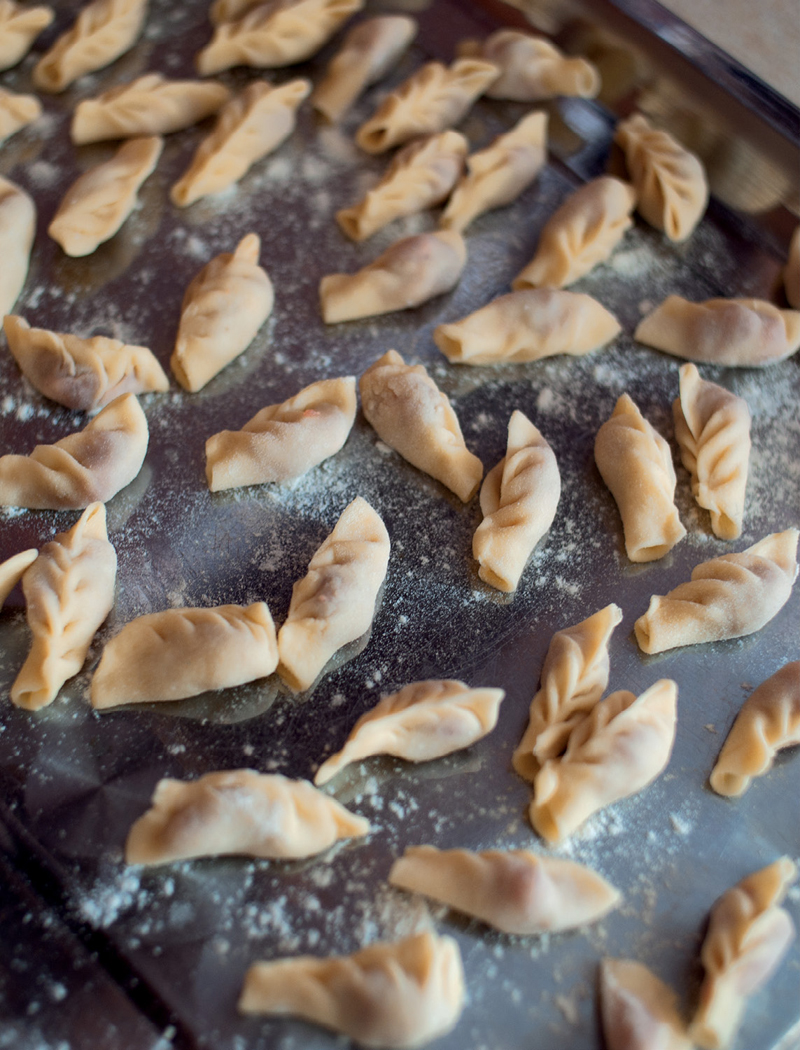
Sheki, Azerbaijan—Homemade jirs, or tiny pleated dumplings, shaped in Matanet’s kitchen, where I learned to make them (see Mini Dumplings).
Stuffed vegetables and leaves are a tradition in the Caucasus and Kurdistan. They’re usually known in the West by the Turkish and Arabic name dolma. In restaurants and for feasts, the filling is often meat-based, whereas home cooks are more likely to use herbs and aromatics held together with rice or ground nuts or legumes.
The other thing to know about dolmas is that people disagree about where the idea originated. It’s one of the footballs that gets kicked around when there are culinary nationalists arguing about whose heritage is richer or older or better. Whatever their origins, dolmas are a good way to feed a crowd.
The easiest vegetables to stuff, of course, are those that make good containers: bell peppers, for example, with their tops cut off and seeds and membranes stripped out. In Armenia, a larger vegetable container—pumpkin—is stuffed with rice, nuts, and dried fruit (see recipe). The cabbage, workhorse of the garden and the larder, comes into its own: its leaves make ideal wrappers for meat fillings, and for vegetarian ones too, especially in winter, when other vegetables are not easily available. See Cabbage Dolmas and Cabbage Rolls Stuffed with Beans and Tart Fruit.
It’s a short step from using vegetables as containers to using dough to enclose flavorful fillings of meat or vegetables or cheese. Dumplings may be large, like the succulent topknot-shaped dumplings the Georgians call khinkali (see recipe), or small, like Azeri jirs (see recipe). They’re always welcome, and such a pleasure to eat.
Clockwise from top: Georgian Topknot Dumplings (see recipe), Fried Eggplant Roll-Ups, Red Ajika (see recipe), and Garlic-Vinegar Dipping Sauce (see recipe).
These succulent roll-ups are one of the treasures of the Georgian table. Strips of fried eggplant are coated with spiced walnut paste and rolled up. They’re best if made an hour or more ahead of time and slightly chilled, so that the filling firms up and the flavors have time to blend.
Badrigiani make a great appetizer, though in Georgia they are usually served as part of a wide selection of dishes at a meal.
Serves 6 to 8
5 narrow Asian eggplants, about 12 inches long; or 10 Asian eggplants, about 8 inches long; or 2 pounds Mediterranean eggplant
Sea salt
About 3 tablespoons sunflower or extra-virgin olive oil
¾ cup walnuts or walnut pieces
2 garlic cloves, minced
1 teaspoon ground coriander (see Note)
1 teaspoon ground blue fenugreek, or ¾ teaspoon powdered dried fenugreek plus ½ teaspoon ground fenugreek leaves (see Note)
½ teaspoon sea salt
Scant ¼ teaspoon powdered dried red chiles (optional; see Note)
½ cup minced fresh coriander
½ cup minced fresh mint
3 scallions, trimmed and finely chopped
1 tablespoon white wine vinegar or fresh lemon juice
Trim the stems off the eggplants and discard. Slice the eggplants lengthwise into ¼-inch-thick strips; if the eggplants are very long or very wide, cut the slices in half crosswise or lengthwise to yield strips 4 to 6 inches long and 1½ to 2 inches wide. Lay the slices on a parchment-lined baking sheet and sprinkle on salt generously. Set another baking sheet on top and weight it down with a heavy cast-iron pan (or set up an equivalent arrangement) and set the eggplant aside for an hour or so to drain and compress.
Meanwhile, make the filling: Combine the walnuts, garlic, ground spices, salt, and chiles in a food processor or a mortar and process or pound to blend thoroughly. Transfer to a bowl and stir in the herbs, scallions, and vinegar or lemon juice.
Rinse the eggplant strips thoroughly in a colander and squeeze dry. Place a wide heavy skillet over medium-high heat, add 2 tablespoons oil, and heat until hot. Slide some eggplant strips into the oil, without crowding, lower the heat to medium, and fry, turning once, until cooked through, about 10 minutes. Lift out onto a paper towel–lined plate or baking sheet and set aside until cool enough to handle. Repeat with the remaining eggplant, adding more oil as necessary and heating it until hot before adding more eggplant.
Spread some filling on each eggplant strip, roll up, and set seam side down on a platter. Serve at room temperature.
Note: If you have Georgian spice blend, either homemade (see recipe) or store-bought (see Glossary), use 1 tablespoon of the blend instead of the coriander, fenugreek, and chiles.
I’ve also eaten red bell peppers with walnut paste in Georgia. It’s a very successful combo. The peppers are blanched in boiling water for several minutes to soften them slightly, cut into boat-shaped sections, stripped of membranes and seeds, and topped with the paste.
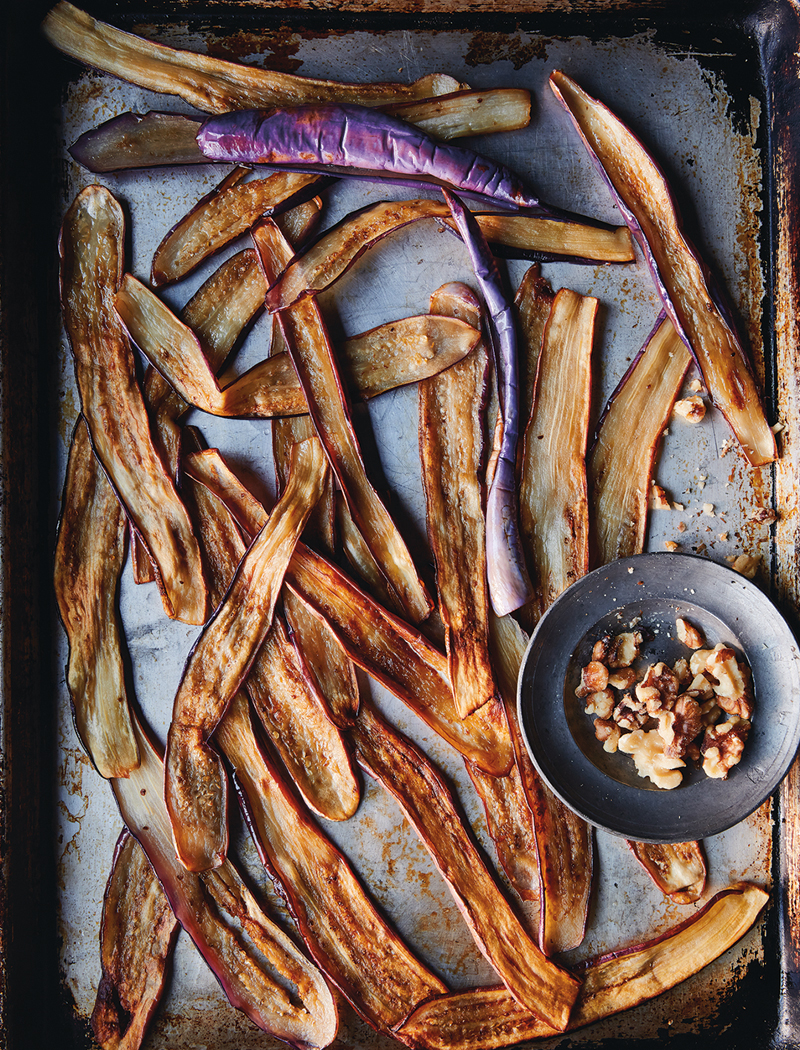
Strips of eggplant that have been fried in preparation for making Fried Eggplant Roll-Ups. With them are walnuts in a bowl.
Until recently, in Armenian villages at harvesttime, a huge pumpkin would be filled with flavored rice and put like a large pot in the waning heat of the community oven. The whole village would share in the feast.
This is a home-style version of that warming comfort food. A small pumpkin is filled with a mixture of rice, walnuts, dried apricots, and dried sour plums (for which I usually substitute dried barberries). Be sure not to fill the pumpkin more than halfway, because the rice needs space to expand.
I discovered when I made this at home for the first time that pumpkin is a great insulator: When I checked on it after an hour in the oven, the rice-cooking water inside the pumpkin was barely lukewarm. Now I start with warm water. You need to allow about two hours for the rice to cook. The pumpkin rice can be served hot or at room temperature. Grill some Turkey Kebabs (see recipe) or other kebabs, and start with Herbed Yogurt Soup (see recipe) with its fresh greenness or a borani of some kind (see recipes here and here).
Serves 8
One 9- to 11-inch-wide pie/soup pumpkin
1½ to 2 cups (depending on the size of the pumpkin) Arborio or other short-grain rice
2 tablespoons butter
About ½ cup coarsely chopped walnuts
About ½ cup coarsely chopped dried apricots
6 dried sour plums, coarsely chopped, or 2 to 3 tablespoons dried barberries (see Glossary), soaked for 10 minutes in warm water and drained
About 2½ cups warm water
1½ teaspoons sea salt
Place a rack in the center of the oven and preheat the oven to 400°F.
Wash and dry the pumpkin. Leave the stem on; it’s a useful handle. Cut out a lid, about 4 inches across, taking care to hold your knife at an angle; you want the sides of the opening slanted so the lid won’t fall in as the pumpkin cooks. Clean the seeds and membranes from the lid and set the lid aside. Use a strong spoon to scrape the membranes and seeds out of the pumpkin. (Set the seeds aside for another purpose or discard.) Place the pumpkin on a rimmed baking sheet or in a roasting pan.
Wash the rice in several changes of water and set aside in a bowl.
Melt the butter in a large heavy skillet over medium heat. Add the walnuts and dried fruit and cook, stirring frequently, for about 5 minutes, until the fruit is well softened. Add to the rice and mix together.
Spoon the filling into the pumpkin; it should be barely half-filled. Add enough warm water to cover the rice by half an inch or so, then add the salt. Place the lid on the pumpkin and transfer the pumpkin to the oven. Bake until the rice is tender and the outside of the pumpkin is slightly soft to the touch, about 2 hours. Remove from the oven and let stand for 20 minutes to 1 hour to allow the filling to firm up.
To serve, place the pumpkin on a platter; it’s fun to serve this at the table. Remove the lid and use a long-handled spoon to scoop out the rice, along with tender pumpkin flesh.
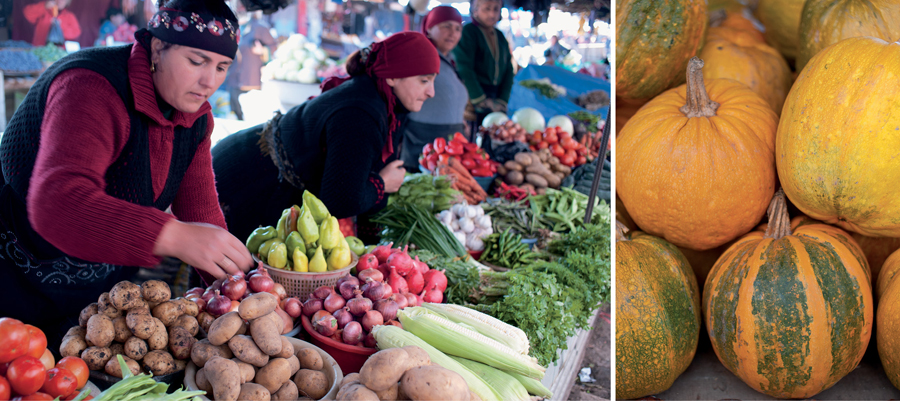
Tbilisi, Georgia—Market women with their produce in October. Pumpkins are used as a vegetable throughout the Caucasus countries and in Iran and Kurdistan.
This wintertime classic exists in various forms all through the Caucasus countries, perhaps because of the Russian influence there. The filling is spiced ground meat: beef or lamb in Azerbaijan, beef or pork in Armenia and Georgia, mixed with rice and spices. There are also meatless versions for fasting times: see Cabbage Rolls Stuffed with Beans and Tart Fruit.
Serves 8
2 medium onions (½ pound), coarsely chopped
2 medium Roma (plum) tomatoes, peeled and chopped
2 pounds ground lamb or beef (at least 25% fat)
1 teaspoon ground ginger
2 teaspoons sea salt
1 teaspoon freshly ground black pepper
1 cup jasmine or other medium- or short-grain rice, washed and drained
½ cup minced fresh coriander
One 3-pound green cabbage
Sea salt
Plain full-fat yogurt or Pomegranate-Coriander Sauce (see recipe)
Make the filling at least 3 hours and as long as a day before you want to serve the rolls: Put the onions in a food processor and pulse until reduced to a soft mush (be patient, they will eventually turn to mush). Add the tomatoes and process until smooth. Add the meat, ginger, salt, and pepper and process to blend well.
Turn the mixture out into a large bowl. Add the rice and coriander, and mix and knead with your hands, squeezing the mixture through your fingers; you want a very smooth texture.
Cover and refrigerate for at least an hour to firm up and blend the flavors before using.
At least 2 hours before you wish to serve the dolmas, wash the cabbage and cut it lengthwise in half. Place in a large heavy pot. Add about 2 inches of salted water, cover, and bring to a boil. Reduce the heat and cook until the cabbage is just tender, about 30 minutes. Drain and set aside to cool.
Cut out the core of the cabbage and separate the leaves. Use a few of the less-than-perfect leaves to line the bottom and lower sides of a wide heavy pot. Pick up one cabbage leaf and trim away the thickest part of the central rib, so the leaf has flexibility. If the leaf is very large (the size varies), cut it in half lengthwise, and just use a half leaf. Lay the leaf on one hand and put 1 heaping tablespoon to 2 tablespoons filling on it (whatever fits comfortably), about an inch from the stem end. Fold over the stem end, fold over the sides, and roll up; patch any gaps with pieces from another leaf if necessary. As you shape them, place the dolmas seam side down in the pot: Arrange them around the sides of the pot first, then fill in the center. Once you have one layer, build a second layer on top.
Add water to just cover. Cover the dolmas with more leaves and put a plate on top to weigh them down. Put the lid on the pot and bring the water to a boil over medium heat. Cook for 30 minutes. Lift the lid and check that the pot has not run dry; add a little water if needed. Cover and cook for another 20 minutes or so. Let cool to lukewarm or to room temperature in the pot before serving. The rolls will firm up as they cool.
Stack the dolmas on a platter, or serve each guest 2 or 3 rolls in a soup bowl or on a plate. Serve with yogurt or Pomegranate-Coriander Sauce.
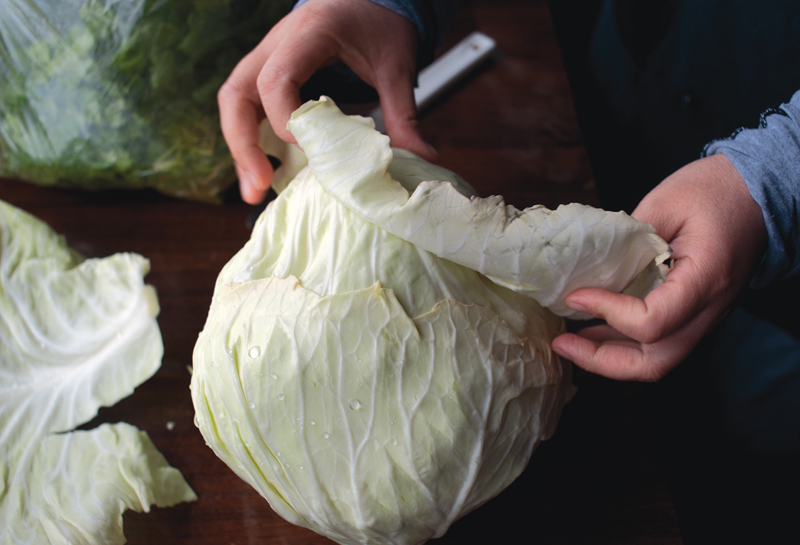
Sheki, Azerbaijan—Peeling the outside (less-perfect) leaves off a beautiful firm cabbage, in Chamala’s kitchen. Next we cut the cabbage in half and steamed it until just tender, so its leaves were supple and easy to roll around the filling.
For the “fasting days” of the Armenian Church, on which no meat or dairy is eaten, Armenian cooks have come up with different versions of many classic dishes. They’re handy for vegetarians as well as for believers.
But these cabbage rolls give no hint of deprivation. They are astonishing: moist, richly flavored, and deeply satisfying. As for the meat-filled cabbage rolls, the cabbage is steam-cooked until softened (in earlier times, brined cabbage would have been used, especially in the early spring, at the Lenten fasting period). The filling is cooked beans, lentils, and some bulgur, flavored with dried fruit and with plenty of onions cooked in generous quantities of oil (a combination known as so karats).
Serves 8
One 3-pound green or white cabbage
½ cup coarse bulgur
1 cup hot water
1 cup sunflower or olive oil
1 cup thinly sliced onion
1½ cups mixed cooked or canned beans and legumes, with a little cooking liquid (see The Precooked Beans Habit), preferably roughly equal parts chickpeas, lentils, and kidney beans
About 2 tablespoons tomato paste
½ cup chopped dried apricots, sour plums, or sour Fruit Leather (see recipe)
Generous grinding of black pepper
1 tablespoon dried mint
1 teaspoon dried thyme or oregano
1 cup chopped mixed fresh herbs, such as coriander, flat-leaf parsley, summer savory, tarragon, and watercress
2 teaspoons sea salt, or to taste
½ cup rose hip liquid (see here) or ¼ cup tart cranberry juice (optional)
Wash the cabbage and cut it lengthwise in half. Place in a large heavy pot, add about 2 inches of salted water, cover, and bring to a boil. Lower the heat and cook until the cabbage is just tender, about 30 minutes. Lift out of the liquid and set aside to cool.
Meanwhile, place the bulgur in a bowl, add the hot water, and set aside to soak for 30 minutes.
Heat the oil in a large pot over medium heat. Add the onion and cook until very softened and translucent, 5 to 7 minutes. Add the beans, bulgur, and tomato paste and stir. If the mixture seems dry, add a little water to moisten it. Add the dried fruit, pepper, and dried herbs and cook, stirring, for a few minutes, until blended and soft. Remove from the heat and stir in the fresh herbs and salt. Taste and adjust the seasoning; set aside. (You will have about 4 cups filling.)
Carefully core the cabbage and separate the leaves. Use a few of the less-than-perfect leaves to line the bottom and lower sides of a wide heavy pot. Use the rest to make dolmas, trimming the central rib of the leaf when necessary to make it supple, cutting very large leaves lengthwise in half, and using about 2 tablespoons of the bean filling for each roll. Lay the leaf on one hand; place the filling about an inch from the stem end, fold over the stem end, fold over the sides, and roll up. As you shape them, place the dolmas seam side down in the pot: Arrange them around the sides of the pot first, then fill in the center. Once you have one layer, build a second layer on top. Cover the stacked dolmas with more cabbage leaves.
Add water, preferably flavored with the rose hip liquid or cranberry juice, to just cover the dolmas. Top with a plate to weigh them down. Cover the pot and bring to a steady boil. Cook for 45 minutes. Remove from the heat and let cool completely in the liquid, or chill in the refrigerator, to firm up the filling.
Serve at room temperature or chilled.
Note: I was told that the cooking liquid may instead be flavored with ground cannabis seeds, which are apparently widely available in the region. I did see large cannabis plants growing in rural Iran.
Left: Sheki, Azerbaijan—Pouring water into a pan of shaped cabbage rolls, in Chamala’s kitchen.
Right: Baku, Azerbaijan—A cabbage seller in Taza Market.
Stuffed vegetables (dolmasy in Azeri, dolma in Armenian, tolma in Georgian, yaprach salat in Kurdish) make great appetizers and also are very good additions to a feast. Make them up to 3 hours ahead.
The filling makes 3½ to 4 cups; multiply it for larger batches. Make it at least two hours and up to a day ahead of when you wish to serve the dolmas. If you are using tomatoes as one of your container vegetables, add 2 tablespoons of the reserved tomato pulp to the meat mixture and omit the tomato paste.
1 pound ground lamb or chicken
1 cup minced onion
1½ teaspoons ground cumin
1 tablespoon tomato paste (see headnote)
Pinch of turmeric
1 teaspoon sea salt
1 teaspoon sunflower or extra-virgin olive oil
1 cup cooked short- or medium-grain rice
½ cup chopped fresh mint, basil, tarragon, or flat-leaf parsley
4 or 5 bell peppers or 10 large tomatoes, or about 20 small eggplants or 25 small zucchini, or a combination
Salt, if using eggplants
To make the filling, place the lamb or chicken, onion, cumin, tomato paste (or tomato pulp), turmeric, and salt in a food processor and process to a smooth paste.
Place a heavy skillet over medium heat. Add the oil and the meat mixture and cook, stirring frequently, until the meat has changed color, 5 to 10 minutes. Stir in the rice and fresh herbs. Remove from the heat and set the mixture aside until you are ready to use it (in a sealed container in the refrigerator if the wait will be longer than an hour).
Meanwhile, prepare your vegetables:
For bell peppers: Cut off the tops and save to use as lids. Strip out and discard the seeds and membranes. Drop the peppers into boiling water for just 30 seconds to blanch them; drain.
For tomatoes: Choose firm large tomatoes. Cut off the tops and set aside to use as lids. Scoop out the flesh and stir 2 tablespoons of it into the meat filling.
For eggplants: Choose small ones. Cut off the stems and make a slit down one side of each one, cutting deeply but not all the way through the eggplant. If using Mediterranean eggplants, rub salt inside the slits and set aside for 30 minutes, then rinse well. Drop the eggplants into a pot of boiling water and blanch for about 3 minutes. Drain.
For zucchini: Choose firm small zucchini that are 4 to 6 inches long. Cut a slit in one side of each one.
Allow about 1 cup filling per pepper, ¼ to ½ cup filling per tomato, about 2 tablespoons filling per small eggplant, or 1 to 2 tablespoons per small zucchini.
Fill the vegetables to the top with the filling. Place the “lids” on the peppers and tomatoes. Place the vegetables in a deep skillet or a wide heavy pot. If you’re making a lot, you’ll need two pots. Stand the tomatoes and peppers upright and place the zucchini and eggplants on their sides, slit side up. The vegetables should fit in snugly so they support each other and stay upright. Add hot water to the pan until it is ¼ inch deep if cooking zucchini, and almost ½ inch deep for other vegetables. Cover tightly and bring to a boil, then reduce the heat and simmer for 15 minutes for tomatoes and zucchini, 30 to 40 minutes for eggplants and peppers, until tender.
I like to serve these at room temperature when the textures have firmed up, so the vegetables are easier to eat, but you can also serve them hot.
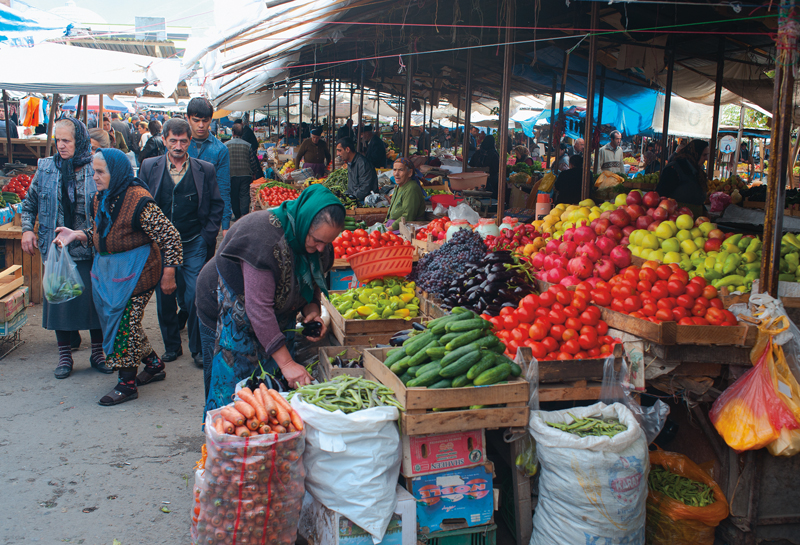
Sheki, Azerbaijan—The market in September is full of the bounty of the rich farmland and gardens in the area.

Mar Odisu, near Amediyah, Kurdistan—Amediyah is a hilltop town that dates back to Assyrian times. Nearby, a sign in Aramaic indicates the way to Mar Odisu, a small Assyrian church and the remnants of a monastery. This woman was sitting in the church when I got there.
In the tiny international lounge at Tabriz airport in northwestern Iran, I fell into conversation with a middle-aged man who spoke fluent English. He was Iranian-born, from the Urumiyah area. He’d been back for a family visit and was now returning to Los Angeles, where he lived with his family. I asked whether he and his wife spoke Persian with their children at home. “No,” he said. “We are Assyrians; we speak Aramaic with them.”
I told him that I had a lot of questions for him about Assyrians, if he didn’t mind? “I’m happy to talk about this,” he said. And so I learned that there are still substantial populations of Assyrians in northwestern Iran, especially near Urumiyah, as well as in Iraqi Kurdistan.
Assyrians are a tenacious people. They have been without a country or kingdom of their own for about 2,600 years, and yet they have kept their written and spoken language, Aramaic. Like Armenians and Georgians, they embraced Christianity early in the Christian era.
In the British Museum, there are extraordinary carved sandstone blocks that were excavated at Nineveh, the Assyrian capital, the ruins of which lie near the east bank of the Tigris River in present-day northern Iraq. They date from the era when the Assyrian Empire under Ashurbanipal stretched from North Africa to central Iran and the Caucasus. They commemorate lion hunts and battles, including one in which the Assyrians defeated the Elamites (the ancestors of present-day Persians). A century after that battle, the Elamites defeated the Assyrians (in 605 BC); the Assyrians never regained an empire.
Six months after that encounter in Tabriz, I was in northern Kurdistan, near the village of Amediyah, visiting an old Assyrian church called Mar Odisu. It was like a chapel, built of whitewashed stone and very spare. An older Assyrian woman who was tending some flowers told me it had been destroyed twice, once long ago by the Mongols, and once by Saddam Hussein. Each time the community had rebuilt it.
Photograph here
Khinkali are Georgian classics, found in small eateries and devoured by the bowlful, hot and steaming. The dough is a simple combination of flour, salt, and water that needs to rest before it is rolled out and cut into wrappers. Because the dumplings are boiled in water, it’s very important that the wrappers be well sealed—that is the origin of the twisted topknot: The dough is pleated together around the filling and twisted firmly to seal it (the process is easier than it sounds).
To eat khinkali, you pick one up by the topknot handle, nibble a hole in the dumpling, and suck out all the juices before eating the rest. Then you set the dough handle aside rather than eat it. You want to leave room for the next dumpling, say the Georgians.
These khinkali are meat-filled. The filling is delicious, so if you have any left over, make it into a small meat patty and fry or grill it for a little snack. Vegetarian khinkali, eaten at fasting times such as Lent, are filled with mushrooms; see the variation that follows.
Tkemali sauce, made from sour plums, is a classic accompaniment, as is a garlic-vinegar sauce, but other dipping sauces also work well, from tomatillo salsa to soy sauce–based Asian sauces to Georgian ajika (see recipe). The dumplings are substantial. If you are serving them as an appetizer or as part of a meal, serve 2 or 3 per person. For a light lunch, allow 5 or 6 per person, with a side salad of some kind.
Serves 8 as an appetizer, 4 as a main course; makes 20 to 24 dumplings
About 3 cups all-purpose flour, plus extra for surfaces
1 teaspoon sea salt
1 cup water
1 pound ground lamb, beef, veal, or pork, or a mixture
½ cup chopped scallion greens
½ teaspoon ground cumin
½ cup chopped fresh coriander
1 teaspoon sea salt
Generous grinding of black pepper
Sea salt
Sour Plum Sauce (see recipe), Garlic-Vinegar Dipping Sauce (recipe follows), or another sauce (see headnote)
To make the dough, place the flour and salt in a bowl, add the water, and mix well. Turn the dough out onto a lightly floured surface and knead for a couple of minutes, until smooth. Alternatively, place the flour and salt in a food processor and, with the processor running, add the water through the feed tube. Process just until the dough comes together, then turn out onto a lightly floured surface and knead briefly. If the dough is still sticky, add more flour to your work surface and knead it in. Seal the dough in a plastic bag and set aside for at least 30 minutes, or up to 6 hours.
To make the filling, mix all ingredients in a bowl and knead well to blend them together, then cover and set aside (refrigerate if the wait will be longer than an hour).
Half an hour before you want to serve the dumplings, bring a large pot of water to a boil over high heat and add 2 tablespoons salt. Cover and keep at a simmer while you prepare the dumplings.
Flour your work surface and turn the dough out. Cut it into 4 pieces. Flatten and stretch one piece of dough, or use a rolling pin to roll it out; you want a thin oval about 10 inches long. Use the rim of a jar or bowl that is about 4 inches in diameter as a guide and cut out circles with a knife, cutting them close together. Pull the scraps together, roll out again, and cut out another circle or two.
Fill the first circles: Place a generous tablespoon of filling in the center of one circle. Pull up a bit of the edge and then another bit next to it, pleating the second one over the first, and continue around the circle until you have created a pillow with a gathered top. Pinch the top ½ inch below the top edges of the dough and twist to seal the topknot well. Set aside on a well-floured surface. Repeat to fill the remaining rolled-out circles of dough. (If your kitchen is very dry, cover the shaped dumplings loosely with plastic wrap or a slightly damp cloth.) Then stretch or roll out a second piece of dough and make more dumplings.
Once the first two batches are shaped, bring the pot of water back to a vigorous boil and toss in the dumplings. They will sink to the bottom and rise again after 5 to 7 minutes; once they have floated up, boil for another minute. Meanwhile, roll out the other pieces of dough and shape the rest of the dumplings.
Lift the cooked dumplings out of the pot with a slotted spoon and serve immediately in individual bowls or on a serving plate. Serve the sauce of your choice on the side. Cook and serve the remaining dumplings.
Mushrooms make a wonderful substitute for meat in many dishes, and they come into their own in the fasting (meatless) recipes of the Armenians and Georgians. To make topknot dumplings with a mushroom filling, sauté 2 or 3 minced garlic cloves in 2 tablespoons sunflower or olive oil in a large heavy skillet until softened. Add 1 pound chopped mushrooms (about 4 cups) and 1 teaspoon sea salt and cook until the mushrooms start to soften. Turn out into a bowl to cool.
Stir ½ cup minced scallions, ¼ cup chopped fresh coriander, ¼ teaspoon ground cumin and a generous grinding of black pepper into the mushrooms. Shape and cook the dumplings as above. Total cooking time for each batch of dumplings will be 5 to 6 minutes. Serve with lightly salted thick yogurt or the garlic-vinegar sauce, or with red or green ajika (see recipes here and here).
Photograph here
A last-minute quick-hit kind of sauce, this is especially good when the garlic is very fresh. Do not make it with tired, overstrong winter garlic! Serve with dumplings or with roast lamb.
Makes about ½ cup
10 medium crisp, fresh garlic cloves (to yield about 3 tablespoons garlic paste)
Pinch of sea salt
About 3 tablespoons red wine vinegar or cider vinegar
2 tablespoons water
Pinch of sugar
A little finely chopped fresh coriander (optional)
Mash the garlic to a paste with the salt in a mortar or a small food processor, or finely mince and mash with a spoon. Place in a small bowl, add the vinegar, water, and sugar, and stir to blend. Taste and adjust the seasoning if necessary. Stir in the coriander if you wish.
Photograph here
Jirs are distant cousins of Georgian Topknot Dumplings (see recipe) and of the boiled dumplings of central Asia that spread to Russia and eastern Europe (think of pierogi, for example). All are a way of creating a filling meal from very little meat.
I learned these in the town of Sheki, in Azerbaijan. My teacher, Matanet, serves jirs in the light broth she creates by cooking them in boiling water tinted very elegantly with saffron threads. Other cooks drain the dumplings and simply serve them topped with a dollop of yogurt. Both options are given below.
You may balk at the busywork of shaping small dumplings, but if you have a friend to work with, the shaping goes quickly and is a pleasure. (If you don’t want to shape dumplings, the filling here can instead be shaped into small sliders, then fried or grilled and served as an appetizer.)
A note on names: Matanet called these little dumplings jirs. But several Azeri sources call small dumplings dushbarai and use the word jirs for larger dumplings. The instructions below are for dumplings that are larger than the jirs I made and ate in Sheki; at 2 inches in diameter, they are easier to shape.
Serves 6; makes about 80 small dumplings
1 large egg
½ cup plain full-fat yogurt
1 teaspoon sea salt
1½ cups all-purpose flour, plus extra for surfaces
¼ pound ground lamb or beef
1 medium onion, coarsely chopped
2 tablespoons tomato paste
¾ teaspoon ground cassia (cinnamon)
¼ cup packed minced fresh coriander, dill, or tarragon
1 teaspoon dried mint
Generous pinch (¼ teaspoon) of saffron threads
¼ cup hot water
5 cups water
1 teaspoon sea salt
2 tablespoons chopped fresh coriander or 1 teaspoon dried mint
Garlic-Vinegar Dipping Sauce (see recipe)
Ground sumac
Sea salt and freshly ground black pepper
To make the dumplings, mix together the egg and yogurt in a medium bowl. Add ½ teaspoon of the salt and stir. Add 1 cup of the flour and stir to blend it in well. Add another ¼ to ½ cup flour and stir. Turn the dough out onto a well-floured surface and knead until very smooth and not at all sticky. Set aside, covered with plastic, to rest for half an hour.
Meanwhile, put the meat, onion, tomato paste, cassia, herbs, and the remaining ½ teaspoon salt in a food processor and process to a paste. Set aside, covered, in the refrigerator for 30 minutes.
For the broth, put the saffron threads in a small bowl, add the hot water, stir, and set aside to steep.
Line a baking sheet with parchment paper or wax paper.
Cut the dough in half and set one piece aside, covered, to prevent it from drying out. On a well-floured surface, roll out the other piece until very thin. Just keep at it, rolling from the center outward and rotating the dough slightly after each stroke, until it is a round or an oval about 15 inches across or more. Use a glass or a round cookie cutter, dipped in flour, to cut out 2-inch rounds. Pull together the remnants, roll them out thinly, and cut out more rounds.
Place about ½ teaspoon filling in a line down the center of one round. Press the filling to compact it and make sure the edges of the dough are bare. Using your lightly floured thumb and forefinger, pinch the dough together at one end of the line of filling. Then, pinching over a tiny pleat, first from one side and then the other, work your way along the two edges, sealing them together (see photo). Place the dumpling on the baking sheet and fill and shape the remaining rounds. Repeat the rolling out, cutting, and shaping with the remaining dough and filling.
Pour 5 cups water into a wide pot and bring to a rigorous boil. Add the salt and the saffron liquid. Carefully transfer all the dumplings to the water and stir gently to prevent them from sticking together. Cook at a medium boil for about 12 minutes, until the dough is very tender.
To serve, ladle the dumplings and broth into individual soup bowls. Sprinkle with the coriander or dried mint. Put out a dish of the sauce. Set a small bowl of ground sumac on the table, as well as salt and pepper. Serve with flatbreads.
If you prefer to serve the dumplings without their broth, omit the saffron. Serve them in individual shallow bowls or plates, sprinkle on chopped fresh herbs or a little sumac, and offer a bowl of thick yogurt seasoned with salt and a little minced garlic as a side sauce.
Matanet told me about a “fantasia” version of jirs, filled with a mix of chopped dates and walnuts. They’re sweet morsels, and unusual. To make them, chop ½ cup soft pitted dates. Add to ½ cup finely ground walnuts and stir and blend the two together. Add ½ teaspoon ground cardamom and/or ½ teaspoon ground ginger. Fill each dough round with about ½ teaspoon filling, as above. You can make the dumplings ahead and set them aside for up to 4 hours, loosely covered with a cotton cloth.
When ready to proceed, bring a large pot of water (unsalted) to a rolling boil and add the dumplings. Stir gently and cook for 6 to 7 minutes until the dough is very tender. Use a slotted spoon to transfer the dumplings to a platter. Drizzle on a little melted butter and toss gently to coat. If you wish, lightly dust them with cinnamon sugar (2 teaspoons sugar combined with ½ teaspoon cassia or cinnamon). Serve warm with tea or coffee.
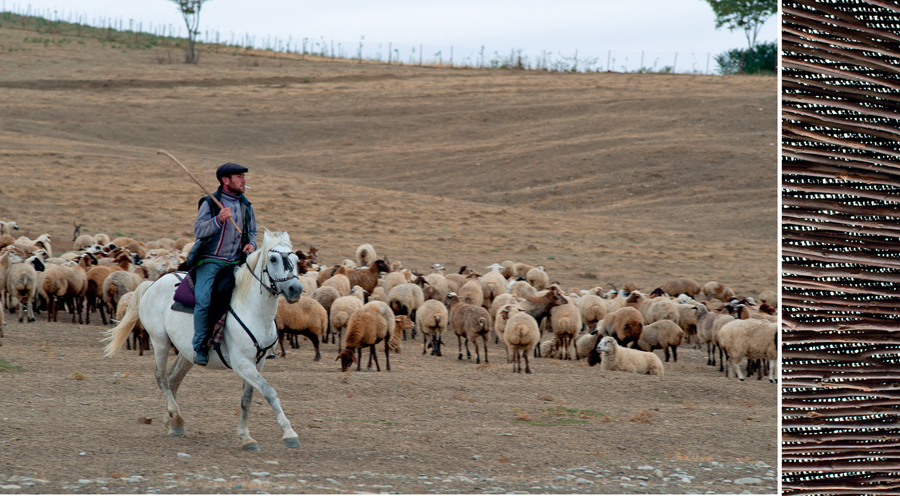
Left: Near Shamakhi, Azerbaijan—Many shepherds in Armenia and Azerbaijan work from horseback, keeping their flocks fed by finding new pasture for the animals. This guy had real style.
Right: Southern Iran—Detail of a nomad tent (see Nomad Encounter).